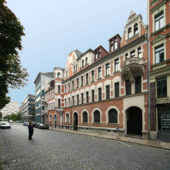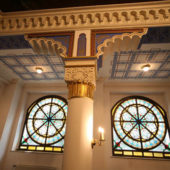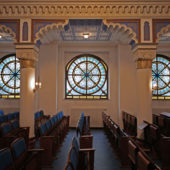The synagogue blends unobtrusively with neighboring buildings.
The name “Leipzig” is derived from the Slavik word Lipsk, which translated, means: “settlement where the lime trees stand.” The first record of Jews in Leipzig, is found in a document by Isaac b. Moses between 1250 and 1258. A Jewish community with a synagogue and school was established from the second quarter of the 13th century. The Jews at that time were involved in money-lending and merchant trades since they were not allowed to engage in other livelihoods. The regulations of Leipzig in 1268 protected the rights of Jewish merchants. The Jewish community may have been blamed for the Black Death, as the margrave took away their synagogue in 1352.
In 1364 Jews are mentioned as living in Judenburg (Jewish houses), a ghetto which had its own gate. Leipzig’s growth as the epicenter of the fur trade was largely due to Jewish trade. Between 1668 and 1764, 82,000 Jews attended Leipzig Trade Fairs, held three times per year, which increased their sales tremendously. This is the oldest remaining trade fair in the world and it was and remains an event of international importance.
Jews were prohibited from having shops with their fronts facing the street. They were also not allowed to hold religious services of any kind. A Jewish cemetery was not permitted until 1815. In 1710, a permanent Jewish settlement was obtained when Gerd Levi, mintmaster and purveyor, was granted rights of residence. By the middle of the 18th century the number of Jewish families allowed to reside in Leipzig grew to seven. After the Seven Years’ War (in 1756-63), Jews held services in several prayer rooms during the merchant fairs. By the end of the 18th century, forty to fifty Jewish merchants lived in Leipzig and employed clerks, servants, agents and shohatim (ritual slaughterers). In 1837 a law was passed allowing Jews to live in Leipzig. A prayer house, with Reform leanings, was subsequently founded and in 1845 the first rabbi, Adolf Jellink, was hired. Due to his efforts, a synagogue was built and consecrated in 1869 a Reform Synod took place in Leipzig.
In 1905 there were 7,676 Jews living in Leipzig and in 1925, the Jewish community had grown to 13,032 members. A large number of the new community was Orthodox. By 1938, 1,600 Jewish businesses were “aryanized,” and approximately 3,000 Jews had emigrated. In October of 1938 another 1,652 Jews were deported to Poland. During the KristallnarchtI (A coordinated anti-Jewish attack which took place on November 9, 1938), the two main synagogues were burnt down, one of which was the Leipzig Synagogue, shops were looted, and the funeral hall was destroyed. 1,000 more Jews were deported to the concentration camps in Riga, Latvia, early in 1939. 2,500 Jews remained in Leipzig in 1941. They were crowded into the Judenhaeuser and worked as slave labor.
By February of 1945, most of the remaining Jews were deported to death camps in the east via nine transports. When U.S. troops entered Leipzig in April 1945, there were only 24 Jews left in the city. After the war, the Jewish community re-established itself. By 1968 it numbered 100 members. By 2005 the Jewish community increased to 1,133 members. In 2010 the Jews of Leipzig celebrated the founding of the city’s Jewish community. Although they were basically destroyed during WWII and in the 90s’ had a membership of only 35, today there is cause to celebrate “the (growing) remnant” in Leipzig.
The Leipzig Synagogue was built in 1855, in the Moorish Revivalist style. Jewish architect Otto Simonson designed the Synagogue, who studied under Gottfried Semper, the architect of the Semper Synagogue in Dresden, Germany. The Synagogue was commissioned by a small group of Jewish merchants from various countries throughout Europe, who had gathered together for the annual Leipzig Trade Fair. Because so many businessmen come to Leipzig for the Fairs, it is thought that this Synagogue’s design has influenced the architecture of other synagogues across Europe. Although this Synagogue was destroyed on Kristallnacht, since 1995 it has been restored to its original glory.
The exterior of the building blends in unobtrusively with neighboring buildings. The façade features red brick with white molding around the windows and doors. Inside the spacious prayer-room, one is impressed with the intricate detailing and lines, as well as use of strong color and repeated design motifs of the Moorish Revivalist style. The nave itself has three levels, the women’s gallery on the second level, surrounding the sides and back of the sanctuary. Spectacular stained-glass windows adorn the side-walls of the ground floor. The upper story is pierced by arched, stained-glass windows along the side- walls, supported by columns on the first floor. The ceiling is spectacular, with longitudinal and horizontal woodwork creating multi-tiered boxes, in which carved rosettes have been placed. The ceiling has been hand-painted and gilded in turquoise blue, ivory, brown and gold. Paneling with wrought-iron railing is featured across the front of the women’s gallery, and detailed molding in Moorish motifs, hand-painted in turquoise, ivory, brown and gold, is prolific throughout the sanctuary. At the east end of the prayer-room, against the vivid turquoise wall is a mihrab (a semi-circular niche in the wall of a mosque), highlighted in gold. The Aron Kodesh is set inside, carved of wood in a rectangular shape and the two tablets carved in pale wood, with The Ten Commandments gilded in Hebrew sit at the top. A maroon Torah curtain with gold embroidery and tassels is drawn across it. A Star-of-David sits above the Aron Kodesh. There are many levels and sets of the stairs of the bimah leading up to the Aron Kodesh. Twin menorahs sit on a large podium, flanking either side of the Torah curtain. The tivah (reader’s desk) is designed in the style of a mimbar (a pulpit in a mosque where the speaker climbs up steep stairs to stand behind the podium), which sits in front of the Aron Kodesh. An elegant gold gate surrounds the tivah and similar gates are featured at the sides of the bimah and against one of the upper levels of the bimah.
The restoration of this Synagogue and the growth of the Jewish community in Leipzig is testimony to the faith, tenacity and hope of these people. This Synagogue is a beacon to all of Europe as it continues to be appreciated by those who visit yearly from The World Trade Fair, as well as tourists.



